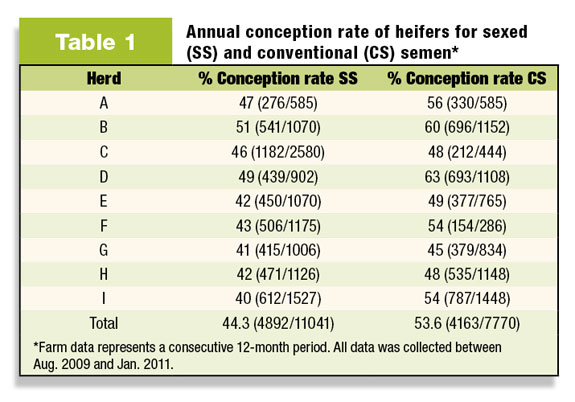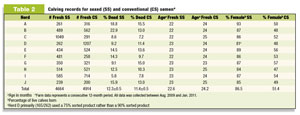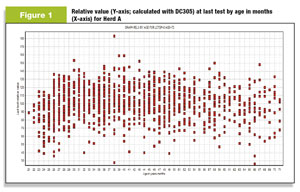Although the technology of sexed semen has been around for a while, many still question if it’s worth the investment. After all, the price of sexed semen for many producers is significantly higher than the cost of conventional semen.
As with any new technology, sexed semen should be questioned and analyzed with trusted experts in the veterinary, academic and industrial communities before being applied to an operation. This article will guide you through considerations and applications for sexed semen on any operation.
Many producers tend to use sexed semen on heifers showing strong heats for one or two services and then switch to conventional semen or natural service for clean-up. This is a practical approach as heifers are generally more fertile than lactating cows and calving difficulty is reduced for heifers carrying a heifer calf compared with a bull calf.
Research data suggests sexed semen will achieve 75 percent of the conception rate of conventional semen (e.g., 45 percent sexed vs. 60 percent conventional in dairy heifers).

The subset of farms in Table 1 achieved approximately 83 percent of the conception rate of conventional semen with their sexed semen. It should be noted heifers were not randomly assigned to semen type (sexed vs. conventional) as they would be in a research setting, but mirrored the likelihood of farms randomly selecting heifers for semen type. The following opportunities could be considered if the reduction in conception rate is a concern.
Increasing quantity
If wanting to increase the number of heifers coming through your system, without purchasing replacements, there are not many opportunities outside of improving the 21-day pregnancy rate in your lactating herd or incorporating sexed semen strategies.
The farms indicated in Table 2 produced 0.87 live heifer calves per freshening with sexed semen and 0.51 live heifer calves per freshening with conventional semen.
Click here or on image at right to view at full size in a new window.
This represents a 69 percent increase in live heifer calves per freshening with sexed semen compared to conventional semen. Considering the cost of good replacement heifers and the managerial adjustments required to improve 21-day pregnancy rates, this presents a huge return on investment for producers looking to expand.
Additionally, sexed semen has a comparable percentage of calves born dead as conventional semen (also seen in Table 2 ), despite the fact the dams are freshening 1.6 months younger. The explanation for the similar numbers of dead calves born, regardless of a 1.6-month age difference, is heifer calves typically cause less calving difficulty than bull calves.
Sexed semen gave the farms included in the tables 1.6 months of milk production instead of 1.6 months of supplying costly feed to a non-lactating animal, while maintaining a similar number of dead calves born.
Finally, it should be noted that in the subset of farms in Table 2 , the first-lactation cows inseminated to sexed semen as heifers have a 305-day mature equivalent of 26,360 pounds while first-lactation cows inseminated to conventional semen as heifers have a 305-day mature equivalent of 26,083 pounds. This illustrates no negative impact of using sexed semen on heifers in terms of first-lactation milk production.
Improving quality
An alternative strategy gaining steam in the dairy industry is to artificially inseminate (A.I.) only superior heifers and cows with sexed semen. This approach increases the proportion of replacements coming from the best dams available on a farm.
While the more common strategy discussed previously can produce a greater number of live heifers per insemination, this strategy focuses on quality rather than quantity of replacement heifers. Without the need or desire to expand a herd, all potential dams should not be viewed equally. Think about your operation for a second.
Certain cows make more money because they produce milk or components at a high level, become pregnant easily and stay out of the hospital pen. Conversely, some cows cost money because they generally have the opposite attributes of the profitable cows. Consider the disparity between the most profitable cows in your herd and the most costly cows in your herd.
To illustrate this point, relative value of the cows in Herd A is shown in Figure 1 . The difference between the top cow and the bottom cow (183 percent vs. 26 percent in this example) is quite large.
Click here or on image at right to view at full size in a new window.
The bottom quarter of the cows in Herd A has an average relative value of 75 percent of their peers, compared with the top quarter which has an average relative value of 125 percent of their peers.
Imagine how much better your herd would be if you got the most replacements possible from the top quarter and kept the fewest replacements necessary from the bottom quarter. If serious about improving genetics, the fastest way to make genetic progress is to select for certain traits from both the paternal and maternal sides!
Producers who want to take an aggressive approach to maternal selection can purchase low-density DNA chips (3K) to determine genetic value of heifers. To achieve the fastest genetic progress, use the top-sexed bulls in the industry that meet your selection criteria.
While the results in the tables may not be identical to what is observed on every farm, they give an indication of what to expect when using sexed semen. While sexed semen does cause a reduction in conception rate compared with conventional semen, there are benefits to sexed semen usage that compensate for the reduction in conception rate.
The herds included in this article did not experience an increase in number of dead calves born or in 305-day mature equivalent, even though there was a 1.6-month difference in age at freshening. Finally, sexed semen can be used for more than increasing heifer numbers; it can also be used to promote genetic selection from the maternal side. PD
References omitted due to space but are available upon request to editor@progressivedairy.com .
âGenex Cooperative, Inc.âs Horizons magazine. April 2011, Vol. 17, Issue 1, pgs. 25-27

-
Colten Green
- National Account Specialist
- Genex Cooperative, Inc.
- Email Colten Green









